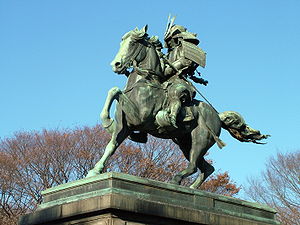Genko war
| date | 1331-1333 |
|---|---|
| place | Japan |
| output | Victory of the Tennō |
| Parties to the conflict | |
|---|---|
|
Troops from Go-Daigo |
|
| Commander | |
|
Hōjō Mototoki
|
|
Kasagi - Akasaka - Chihaya - Kōzuke-Musashi - Kotesashi - Kumegawa - Bubaigawara - Kamakura
The Genkō War ( Japanese 元 弘 の 乱 , Genkō no ran ), also known as the Genkō Incident (Japanese 元 弘 の 変 , Genkō no Hen ) was a civil war in Japan that lasted from 1331 to 1333. The troops of the Tennō Go-Daigo succeeded in defeating the Kamakura shogunate, which led to the temporary Kemmu restoration .
The noun Genkō refers to a Nengō in the Japanese calendar . It comes after Gentoku and before Kenmu . Thus, the Genkō War took place during the Genkō era, which covers the period from August 1331 to January 1334.
root cause
Go-Daigo had ascended the throne as emperor ( Tennō ) in 1318 and strove to oust the Kamakura shogunate , which had formed a de facto military government in Kamakura since the Gempei War of 1185 , and to restore unrestricted rule of the imperial family in Kyoto . The Shogunate was ruled indirectly by the Hōjō Clan as Shikken (regent of the Shōgun). It wanted to actively prevent the emperor from regaining his power.
First uprising
In 1331 Go-Daigo planned to usurp power by force and overthrow the Kamakura shogunate by encouraging his vassals and other anti-Hōjō samurai to revolt. However, Go-Daigo was betrayed when his advisor Fujiwara Sadafusa alerted the shogunate. This sent troops to Kyoto to put down the uprising. Go-Daigo fled with the throne insignia of Japan and sought refuge in a remote monastery on the sacred Mount Kasagi , high above the Kizu River. He managed to escape from there when the monastery was attacked by Kamakura troops during the siege of the Kasagi , but was soon captured. The Hōjō then banished him to the Oki Islands and enthroned Kōgon , the first emperor of the " northern court ", with which they laid the foundation for the coming Namboku-chō period. Go-Daigo's son Moriyoshi continued the fight against the Kamakura shogunate and led his father's supporters at the side of Kusunoki Masashige .
Second uprising
In 1333, two years after his exile, Go-Daigo escaped from the Oki Islands with the help of Nawa Nagatoshi and his family. On Mount Funagami in Hōki Province (in the modern city of Kotoura in Tottori Prefecture ) he raised a new Imperial Army. Meanwhile, Ashikaga Takauji , the military leader of the Hōjō, was sent west to fight the second Go-Daigo uprising. For unknown reasons, however, he ran over to the imperial army shortly before arriving in Kyoto and began to fight against the Hōjō. The reason for Takauji's defection is unknown, but it is believed that he defected because of his unofficial leadership of the Minamoto clan, victor of the Genpei War and arch-rival of the former Taira clan of which the Hōjō belonged. In addition, Takauji may have hoped to be appointed Shogun by Go-Daigo after returning to power.
The Imperial Army lifted the siege of Chihaya , and Imperial General Nitta Yoshisada won a number of victories during the Kōzuke-Musashi campaign in May . In addition to the siege of Chihaya, these included the Battle of Kotesashi , the Battle of Kumegawa and the Battle of Bubaigawara . The Kamakura shogunate was finally defeated in early July during the siege of Kamakura when imperial troops invaded the destroyed city and committed the Hōjō Seppuku .
consequences
Go-Daigo returned triumphantly to Kyōto and claimed power in the so-called Kemmu Restoration for himself. His reign lasted only three years as his followers soon became disaffected and most of the gains of the Genkō War were undone. Many samurai who fought for Go-Daigo were dissatisfied with their reward, and his quest to consolidate imperial power led to their subsequent exclusion from the political affairs that had influenced them significantly under the shogunate. The common people were similarly dissatisfied because Go-Daigo had not addressed the problems they had asked him to solve. In 1336 Ashikaga Takauji appointed himself Shogun and usurped the power of Emperor Go-Daigo to himself. He founded the Ashikaga shogunate on the basis of the Kamakura system, which marked the beginning of the Namboku-chō period.
The history of the Go-Daigo and the Genkō War up to the establishment of the northern and southern imperial courts (Namboku-chō) are described in detail in the forty-volume epic Taiheiki .
literature
- George Sansom: A History of Japan, 1334-1615 . Stanford University Press, Stanford 1961, ISBN 0-8047-0525-9 .
Individual evidence
- ↑ Louis Frédéric : Genkō . In: Japan Encyclopedia . Harvard University Press, Cambridge (Massachusetts) 2002, ISBN 0-674-00770-0 , pp. 238-239 .
- ↑ a b c d Sansom: A History of Japan, 1334-1615 . Pp. 7-11.
